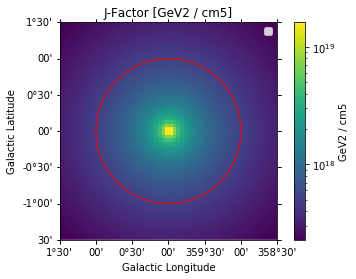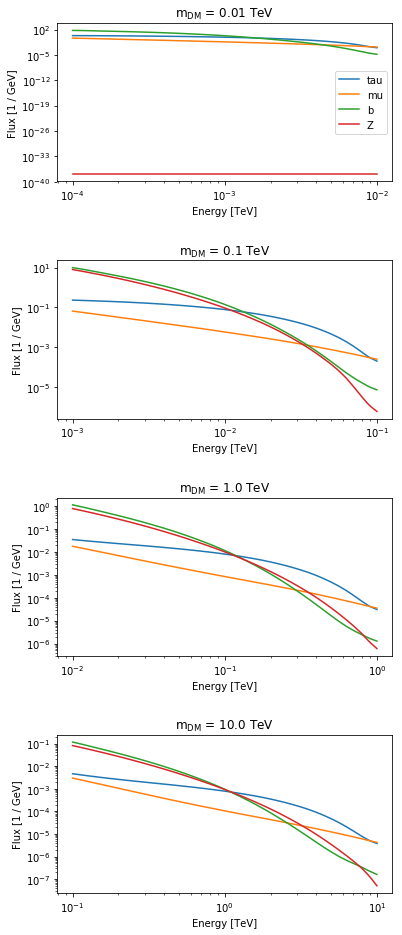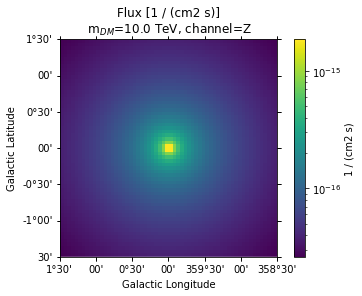This is a fixed-text formatted version of a Jupyter notebook
- Try online
- You can contribute with your own notebooks in this GitHub repository.
- Source files: astro_dark_matter.ipynb | astro_dark_matter.py
Dark matter utilities¶
Introduction¶
Gammapy has some convenience methods for dark matter analyses in gammapy.astro.darkmatter. These include J-Factor computation and calculation the expected gamma flux for a number of annihilation channels. They are presented in this notebook.
The basic concepts of indirect dark matter searches, however, are not explained. So this is aimed at people who already know what the want to do. A good introduction to indirect dark matter searches is given for example in https://arxiv.org/pdf/1012.4515.pdf (Chapter 1 and 5)
Setup¶
As always, we start with some setup for the notebook, and with imports.
[1]:
from gammapy.astro.darkmatter import (
profiles,
JFactory,
PrimaryFlux,
DMAnnihilation,
)
from gammapy.maps import WcsGeom, WcsNDMap
from astropy.coordinates import SkyCoord
from matplotlib.colors import LogNorm
from regions import CircleSkyRegion
import astropy.units as u
import numpy as np
[2]:
%matplotlib inline
import matplotlib.pyplot as plt
Profiles¶
The following dark matter profiles are currently implemented. Each model can be scaled to a given density at a certain distance. These parameters are controlled by profiles.DMProfile.LOCAL_DENSITY and profiles.DMProfile.DISTANCE_GC
[3]:
profiles.DMProfile.__subclasses__()
[3]:
[gammapy.astro.darkmatter.profiles.NFWProfile,
gammapy.astro.darkmatter.profiles.EinastoProfile,
gammapy.astro.darkmatter.profiles.IsothermalProfile,
gammapy.astro.darkmatter.profiles.BurkertProfile,
gammapy.astro.darkmatter.profiles.MooreProfile]
[4]:
for profile in profiles.DMProfile.__subclasses__():
p = profile()
p.scale_to_local_density()
radii = np.logspace(-3, 2, 100) * u.kpc
plt.plot(radii, p(radii), label=p.__class__.__name__)
plt.loglog()
plt.axvline(8.5, linestyle="dashed", color="black", label="local density")
plt.legend()
print(
"The assumed local density is {} at a distance to the GC of {}".format(
profiles.DMProfile.LOCAL_DENSITY, profiles.DMProfile.DISTANCE_GC
)
)
The assumed local density is 0.3 GeV / cm3 at a distance to the GC of 8.33 kpc

J Factors¶
There are utilies to compute J-Factor maps can can serve as a basis to compute J-Factors for certain regions. In the following we compute a J-Factor map for the Galactic Centre region
[5]:
profile = profiles.NFWProfile()
# Adopt standard values used in HESS
profiles.DMProfile.DISTANCE_GC = 8.5 * u.kpc
profiles.DMProfile.LOCAL_DENSITY = 0.39 * u.Unit("GeV / cm3")
profile.scale_to_local_density()
position = SkyCoord(0.0, 0.0, frame="galactic", unit="deg")
geom = WcsGeom.create(binsz=0.05, skydir=position, width=3.0, coordsys="GAL")
[6]:
jfactory = JFactory(
geom=geom, profile=profile, distance=profiles.DMProfile.DISTANCE_GC
)
jfact = jfactory.compute_jfactor()
[7]:
jfact_map = WcsNDMap(geom=geom, data=jfact.value, unit=jfact.unit)
fig, ax, im = jfact_map.plot(cmap="viridis", norm=LogNorm(), add_cbar=True)
plt.title("J-Factor [{}]".format(jfact_map.unit))
# 1 deg circle usually used in H.E.S.S. analyses
sky_reg = CircleSkyRegion(center=position, radius=1 * u.deg)
pix_reg = sky_reg.to_pixel(wcs=geom.wcs)
pix_reg.plot(ax=ax, facecolor="none", edgecolor="red", label="1 deg circle")
plt.legend()
No handles with labels found to put in legend.
[7]:
<matplotlib.legend.Legend at 0x1c24a8dc18>

[8]:
# NOTE: https://arxiv.org/abs/1607.08142 quote 2.67e21 without the +/- 0.3 deg band around the plane
total_jfact = pix_reg.to_mask().multiply(jfact).sum()
print(
"J-factor in 1 deg circle around GC assuming a "
"{} is {:.3g}".format(profile.__class__.__name__, total_jfact)
)
J-factor in 1 deg circle around GC assuming a NFWProfile is 1.35e+21 GeV2 / cm5
Gamma-ray spectra at production¶
The gamma-ray spectrum per annihilation is a further ingredient for a dark matter analysis. The following annihilation channels are supported. For more info see https://arxiv.org/pdf/1012.4515.pdf
[9]:
fluxes = PrimaryFlux(mDM="1 TeV", channel="eL")
print(fluxes.allowed_channels)
['eL', 'eR', 'e', 'muL', 'muR', 'mu', 'tauL', 'tauR', 'tau', 'q', 'c', 'b', 't', 'WL', 'WT', 'W', 'ZL', 'ZT', 'Z', 'g', 'gamma', 'h', 'nu_e', 'nu_mu', 'nu_tau', 'V->e', 'V->mu', 'V->tau']
[10]:
fig, axes = plt.subplots(4, 1, figsize=(6, 16))
mDMs = [0.01, 0.1, 1, 10] * u.TeV
for mDM, ax in zip(mDMs, axes):
fluxes.mDM = mDM
ax.set_title(r"m$_{{\mathrm{{DM}}}}$ = {}".format(mDM))
ax.set_yscale("log")
ax.set_ylabel("dN/dE")
for channel in ["tau", "mu", "b", "Z"]:
fluxes.channel = channel
fluxes.table_model.plot(
energy_range=[mDM / 100, mDM],
ax=ax,
label=channel,
flux_unit="1/GeV",
)
axes[0].legend()
plt.subplots_adjust(hspace=0.5)

Flux maps¶
Finally flux maps can be produced like this:
[11]:
channel = "Z"
massDM = 10 * u.TeV
diff_flux = DMAnnihilation(mass=massDM, channel=channel)
int_flux = (jfact * diff_flux.integral(emin=0.1 * u.TeV, emax=10 * u.TeV)).to(
"cm-2 s-1"
)
[12]:
flux_map = WcsNDMap(geom=geom, data=int_flux.value, unit="cm-2 s-1")
fig, ax, im = flux_map.plot(cmap="viridis", norm=LogNorm(), add_cbar=True)
plt.title(
"Flux [{}]\n m$_{{DM}}$={}, channel={}".format(
int_flux.unit, fluxes.mDM.to("TeV"), fluxes.channel
)
);

[13]: